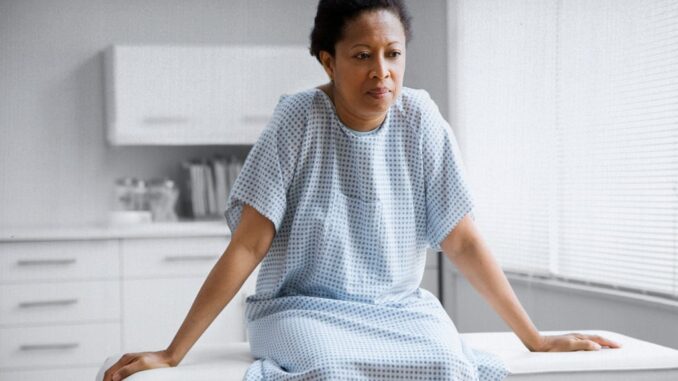
This information comes from an article in Seminars in Reproductive MedicineTrusted Source.
On average, fibroids also affect Black females more severely than white females, with higher rates of severe symptoms and hysterectomy. Black women are also more likely to develop fibroids at a younger age.
This article will discuss how common fibroids are in Black females and the potential causes for this. We will also look at the symptoms, diagnosis, and treatment of fibroids.
Sex and gender exist on spectrums. This article will use the terms “male,” “female,” or both to refer to sex assigned at birth.

In the U.S., the incidence of uterine fibroids Trusted Sourcein Black females is up to 3 times greater than among white females.
Compared with white females of similar socioeconomic status, Black females also tend to develop fibroids:
- at a younger age – 5.3 years younger, on average
- in greater numbers
- of larger size
- that cause more severe disease
- that grow more quickly, in females aged 45 or older
- that do not decline in growth rate with age
There are also differences in treatment and health outcomes. For example, compared with white females, Black females:
- undergo surgical treatment at a younger age
- receive more invasive treatment from doctors
- have higher rates of recurrence after treatment
Black females also experience more significant outcomes for their reproductive health, including being 2.4 timesTrusted Source more likely to have a hysterectomy, which means a person can no longer get pregnant.
Why are fibroids more common in Black females?
There is no firm evidence that explains why fibroids affect Black females more often and more severely than white females. This is partly because researchers are not sure what exactly causes fibroids in anyone.
There is also a lack of research on how and why fibroids develop in people of color and why invasive surgery is more common.
Researchers have suggested that the following factors may play a role in the prevalence and severity of fibroids among Black females:
Family history
Fibroids appear to be more likelyTrusted Source if a person has close relatives who also develop them. This is true regardless of race, ethnicity, or nationality.
However, there are currently no studies that have identified a genetic component in the development of fibroids in any group.
Diet and nutrition
ResearchersTrusted Source believe there may be a link between nutrition, body weight, and fibroids. People with a higher body weight may be more likely to develop them.
According to the American Psychological Association, obesity is more common among Black people in the U.S. than other groups, which could explain the higher prevalence of fibroids in Black females.
The higher rates of obesity in Black communities result from health inequity and socioeconomic inequality, which systemic racism perpetuates.
On average, predominantly Black neighborhoods have less access to fresh and healthy food or affordable, safe spaces for exercise.
Vitamin D deficiency
Some studiesTrusted Source have found a correlation between vitamin D deficiency and higher rates of fibroids. This may affect people with darker skin more than people with lighter skin because they have more melanin in their skin. Higher levels of melanin prevent the skin from synthesizing as much vitamin D from sunlight.
Taking vitamin D supplements may have a protective effect against fibroids.
Learn about vitamin D deficiency here.
Difficulty accessing healthcare
Systemic racism also makes it more difficult for marginalized groups to access quality healthcare and health insurance.
This can make seeking treatment for fibroids expensive, stressful, or in some cases, less effective, as people in rural areas may not have accessTrusted Source to the same treatments.
People in this position may avoid seeking help or wait until symptoms have become severe before reporting them.
Black females can also have difficulty getting appropriate healthcare once they do speak to a doctor. For example, a 2016 study revealed that many medical students believed in false biological differences between races, including a false perception that Black people feel less pain than white people.
This, along with other explicit or implicit biases, could explain why doctors seem more likely to recommend invasive procedures in Black females with fibroids.
Perceptions about periods
Heavy periods and pelvic pain are common fibroid symptoms. Individuals and healthcare professionals sometimes overlook these symptoms or believe they are a normal part of menstruation. As a result, many females do not seek treatment for fibroids for over 3 yearsTrusted Source.
A 2015 surveyTrusted Source on the impact that fibroids have on mental health found that half of the 60 participants felt helpless because they thought they had no control over it. Nearly 62% of the participants were African American.
Can hair relaxers cause fibroids?
There is evidence to suggest that the use of hair relaxers increases the risk of uterine fibroids.
The 1997–2009 Black Women’s Health Study assessed hair relaxer use in more than 23,000 females. Throughout the study, the researchers found a positive trendTrusted Source between hair relaxer use and fibroids.
Fibroids were more likely in participants who:
- used hair relaxers more frequently
- used hair relaxers long-term
- experienced more burns on the scalp
Medically reviewed by Valinda Riggins Nwadike, MD, MPH — Written by Jayne Leonard on April 27, 2021

Be the first to comment